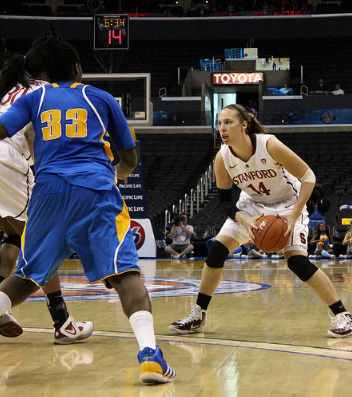Athletic Scholarships
If you are a talented athlete looking for athletic scholarships for 2025, the process is different than many other scholarships. You will want to start the process as early as your freshman year in high school.
College sports are frequently the most prominent social and national events. This makes the student-athletes the most public and visible pool of college applicants who often enjoy special admission consideration. Therefore, many colleges and universities have well-established procedures for recruiting and admission of student-athletes.
Last updated on November 2, 2025 by College Financial Aid Advice.
Athletic Scholarship Associations
There are several college athletic associations. These are non-profit organizations that govern the athletic programs in many colleges and universities in the U.S. and Canada. Furthermore, they set the rules for recruiting, eligibility requirements and athletic scholarships for their member universities. The largest three such associations are NCAA, NAIA and NJCAA which are also called conferences.
NCAA
National Collegiate Athletic Association
NCAA is the largest and most influential intercollegiate athletic association. The largest colleges and universities are members of the NCAA. Furthermore, NCAA is comprised of three different Divisions I, II and III. Currently there are more than 1,200 different member institutions of higher learning in the NCAA, accommodating more than 444,000 student-athletes, in 23 different sports, who compete on 18,000 different teams in all three Divisions.
Under NCAA regulations, Division I and Division II member universities can award athletic scholarships that are exclusively based on the student applicant’s athletic ability. However, Division III member schools are prohibited from this practice and may only award financial aid based on the student’s financial need or academic merit. Be sure to complete your FAFSA financial aid application, which determines your eligibility for many types of financial aid. There are also many academic Merit Based Scholarships.
NAIA
National Association of Intercollegiate Athletics
NAIA is a smaller athletic association than NCAA. NAIA members are comprised of smaller 4-year colleges and universities. Furthermore, NAIA consists of two different Divisions I and II athletics. Currently, there are about 300 member institutions, accommodating more than 60,000 student athletes, in 13 different sports in both Divisions.
Under NAIA regulations, all member institutions can offer athletic and sport scholarships on both Division I and II levels. Division I athletics in NAIA is comparable to Division II athletics in NCAA. In general, NAIA eligibility requirements and athletic scholarship rules are not as rigid as those for the NCAA.
NJCAA
National Junior College Athletic Association
NJCAA members consist of Junior (2-year) and community college’s athletic departments in the U.S. NJCAA is the second largest national intercollegiate athletic association. It is divided into three Divisions I, II, and III across 24 geographic Regions. Currently there over 500 member colleges in 43 states, accommodating over 60,000 student-athletes competing in 28 different sports.
Under NJCAA, Division I and II colleges can offer full or partial athletic scholarships. Division III colleges do not offer any funding for the student-athletes. The eligibility requirements and athletic scholarship rules may vary by member colleges. The Student- athletes who are applying to Division III colleges may still qualify for need-based financial aid. Be sure to complete your FAFSA financial aid application, which determines your eligibility for many types of financial aid.
Student Athlete Scholarships
If you are a student with an athletic gift your search starts in your freshman year because the national athletic associations’ academic eligibility requirements start with your 9th grade.
The national athletic associations (e.g. NCAA or NAIA) do not offer athletic scholarships. Rather, individual member institutions do. As such, colleges and universities which are members of NCAA award more than $ 1.5 billion in athletic scholarships every year… And NAIA awards more than $450 million annually in financial aid.
The athletic recruiting standards often depend on whether the institution is recruiting for a revenue-generating sport such as football where they use one set of standards vs. a non-revenue-generating sport such as tennis where they use a higher set of standards.
As a college-bound student-athlete, you should inform your high school counselors and athletic coaches of your college intentions early on and learn to be your own advocate.
Athletic Scholarship Requirements for NCAA institutions
• NCAA institutions do not look at your overall GPA. Instead, they only consider your GPA in core curriculum classes such as English, math and sciences. Certain classes that meet your high school graduation requirements might not be approved by NCAA. Therefore, for a specific list of NCAA approved courses in your high school, you may visit the NCAA website at ncaa.org
• NCAA Divisions I and II require completion of 16 high school core classes. For a comprehensive overview of the NCAA eligibility you may visit the NCAA website.
• The GPA/SAT/ACT scores are based on a sliding scale such that if your core GPA is high, you can have lower SAT/ACT test scores. For example, for the minimum accepted GPA of 2.00, your SAT (verbal & math) and ACT (sum, not composite) scores for NCAA Division I sports must be a minimum of 1010 and 86 respectively (Beginning with 2016-2017 academic year, this SAT score will be raised to 1020). However, if your GPA is 3.50, you can have a lower SAT score of 420 or a lower ACT score of 39 and still be eligible for NCAA Division I sports.
• You may also download a free copy of the current year NCAA publication ‘NCAA Division I Manual by visiting the NCAA publications website at www.ncaapublications.com
• Even if you meet the NCAA academic requirements, there is no guaranty that you would be admitted to the college of your choice or receive athletic scholarships. This is because the coaches at most selective colleges and universities, regardless of the Division I, II, or III, have only partial influence in the admission process but do not have control over the final decision.
• If you apply to a school and receive a verbal offer from that school or school’s coach, it is not a guarantee for admission. You should always ask for the offer in writing.
Athletic Scholarships Requirements for NAIA institutions
• NAIA has an eligibility center. All first-time student athletes who are applying to NAIA schools must register with this center. To register, you may visit the NAIA website at www.playnaia.org
• The minimum non-weighted GPA for NAIA is 3.0 at the end of the student’s junior year or a 2.5 in the middle of the student’s senior year. The minimum SAT (verbal & math) score is 860 and the minimum ACT score is 18. Also, the SAT scores must be from the same testing date.
• When registering with NAIA Eligibility center, you may create a resume of your academic and athletic achievements. You can submit this resume directly to the coaches and the admissions offices of up to 5 schools. This puts you in touch with the NAIA coaches who can contact you directly.
• For more detailed information for playing sports at a NAIA school you may visit their website www.playnaia.org
Student Athlete's Advice
Aim for the Extraordinary!
- Adaadinchezo from Texas
As a current senior in high school, my biggest advice to anyone would be to study your heart out. Colleges are always willing to help studious applicants who will use their time wisely on the school’s campus. Aside from good grades, colleges want students who engage in various extracurricular activities. I played volleyball all four years of high school, and that shows that I was committed to my favorite sport. If you are a talented player on one of your school’s sports teams, there is a chance of college coaches scouting you out to play for their own college team. Athletes always have a strong chance of college grants if they are asked to play for the school! But to truly give an application the wow factor, I suggest breaking out of the norm of an average high school student and doing something extraordinary.
Locking Up the College of Your Choice as a Student Athlete
- Brennan from Minnesota
The number one thing as a student is to determine if you want to be a student athlete or a student at college. Once you have determined that it will make your college search much easier. For me, I wanted to be come a student athlete. With that in mind, it was my top priority to succeed at the sport I wanted to play at the next level, baseball.
Baseball was and is my passion for a sport. I obtained a NCAA/NAIA College directory that contained all Divisions for every college you can imagine. From that I put together an athletic resume', which I did extensive research on Google.com for examples so that I knew what the most important factors were to catch a college coach's eye. I then obtained 3 letters of recommendation from my high school coach, American Legion baseball coach and my amateur baseball coach. I also put together all my statistics from baseball, along with awards and newspaper clippings. I enrolled in the Baseball Factory program to have a video produced of my fielding, throwing and hitting. This all contained velocity, bat speed and 60/120 yard dash. This was copied of many other CD's and compiled and put into a very nice booklet along with an introduction letter that was mailed to about 50 Division I and Division II colleges.
I
followed up about 2 weeks later with an email to each and every one of those
coaches. I received about a 50% return/feedback off of the product I sent out,
with much interest. I then attended many college camps, went on college visits
and college showcases. All of these did not go un-noticed as I had many many
coaches sending me information and calling me. I then narrowed it down to the
demographical area of which I wanted to stay in and pursued these colleges. It
was about 5 colleges.
I went with my gut instinct and how honest I
felt they were being with me, they type of college it was or appeared to be,
how updated the college was and what it had to offer. Ultimately your education
is the most important part of going on to the next phase of your life. For me
it will be the most important and then the sports side will be second. I did
receive a scholarship to play
baseball at a Division II college with a top rated national team and am very
proud of that. The bottom line is you need to put extensive work into locking
up the college of your dreams once you can determine the exact backing of what
you would like to do once you get there. This will direct you on what
scholarships to apply for and will push you to work hard for what you want.
I have learned that the most important time to
really make a difference is your junior year in high school, that is by far the
most important year for colleges to see you and want you. I wish I had more
direction that I did but I also know that I did receive quite a bit of helpful
information from coaches and the colleges themselves as I started my search
very early in my junior year. It is a choice that will make a huge impact on
your life as you take a step to the next chapter in life.
My mother has been there for me every step of the
way helping and assisting me. This is another important support group, your
parents. Your parents can pose some important and valuable information and
criteria to think about and consider. College is a huge decision, I guess I
never thought it was this hard of a decision to make and didn’t realize the
impact it will leave. I am happy with my decision and can tell you if you are a
student athlete please take into consideration the items I stated above. It is a
process and if followed and researched accordingly I believe you will have much
success in your future as well.
More Scholarships
Scholarships for College Students
Scholarships for High School Seniors
Scholarships for High School Juniors
Welcome!
Welcome to College Financial Aid Advice, a website full of information on scholarships and grants, student loans, and other ways to save money at college.
Important Things to Do
Scholarships for 2026 - 2027 - It is never too early or too late to work on your scholarship searches. If you are part of the high school class of 2026, you should work on your scholarship and college search now. See our list of Scholarships for High School Seniors
FAFSA - The official 2026 - 2027 FAFSA is available now. FAFSA.
College Financial Aid Tips
Scholarship Lists An overview of the different types of Scholarship Money for College.
Grants Learn more about grants, the other free money for college.
Need Tuition Help? Reduce the cost of tuition with these college Tuition Assistance Programs.
Tax Credit Claim the American Opportunity Tax Credit.
College Savings Plans Save money for college with these College Savings Plans.
Need a Student Loan? Yes, you qualify for these college Student Loans.
Popular Scholarship Searches
Scholarships for High School Students


